5 Facts About Non-Surgical Hair Transplant by Dr. Piya

Welcome to another insightful episode of Behind Cosmetic Surgery By Dr. Piya where we delve into the fascinating world of cosmetic surgery and answer all your pressing questions with the guidance of our esteemed expert, Dr. Piya Rungruxsiri,MD. Known affectionately as ‘Dr. Piya,’ he is not just a well-recognized name in the field of cosmetic surgery but also a board-certified plastic surgeon who has earned his credentials from the prestigious International Society of Aesthetic Plastic Surgery (ISAPS) and American Society of Plastic Surgeons.
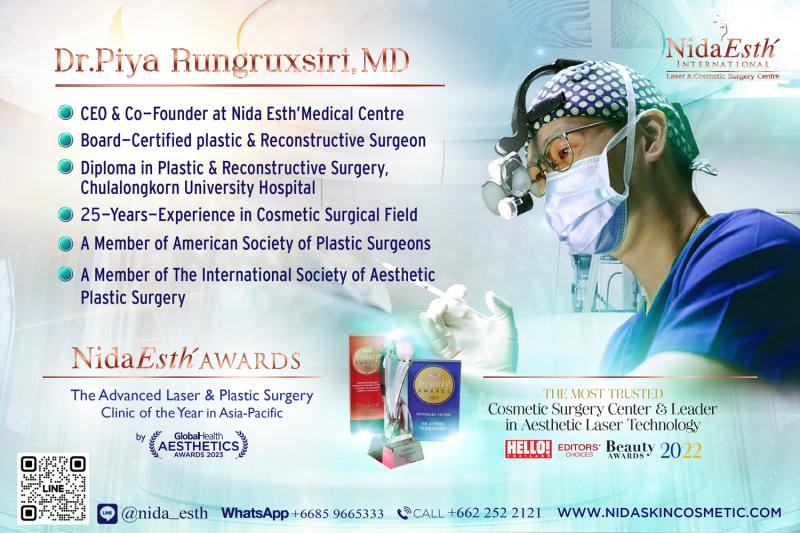
Dr. Piya practices as a CEO & consultant plastic surgeon at Nida Esth’ International, Bangkok’s leading cosmetic medical facility. Renowned for its cutting-edge treatments & technologies and exceptional patient care and was honored with the title of ‘Most Innovative Non-Surgical Hair Transplant Clinic of Asia Pacific’ by Global Health Asia Pacific in 2023. This accolade highlights the clinic’s commitment to pushing the boundaries of what’s possible in non-invasive hair restoration, making it the No.1 beauty destination for celebrities, national leaders and high-class individuals who are seeking the latest in aesthetic advancements
As a plastic surgeon deeply committed to restoring both the appearance and confidence of my patients, my journey in treating hair loss has been one of continual exploration and innovation. Over the years, I have encountered numerous individuals seeking effective solutions that don’t require the invasiveness of traditional surgery. This has led me to integrate some of the most cutting-edge non-surgical hair restoration methods available today into my practice.
In this article, I will share with you the core concepts that drive these revolutionary treatments. We’ll explore the stem cell-based UR Cell Hair Micro Transplant+, a procedure that rejuvenates hair follicles at the most fundamental level using the regenerative power of stem cells. We’ll also delve into the laser-based Fotona HAIRestart, a state-of-the-art technology that employs targeted laser energy to stimulate natural hair growth and enhance scalp health. Finally, we’ll examine the growth factor-based HARG therapy, a treatment designed to harness the potent biological molecules that play a crucial role in hair regrowth.
Each of these techniques represents a leap forward in non-surgical hair restoration, offering patients a chance to reclaim their hair and confidence with minimal downtime and maximal results. By understanding these key concepts, you can make an informed decision about the best approach for your unique situation.
1.What is Non-Surgical Hair Transplant?
Non-surgical hair transplants are innovative procedures designed to restore hair by stimulating the scalp’s natural hair growth processes, without the need of surgical incisions or grafts. These methods are based on advanced scientific principles that harness the body’s inherent regenerative capabilities. The following are the three primary non-surgical hair transplant techniques:
1.1 Stem Cell Concept: UR Cell Hair Micro Transplant+
Ur Cell Hair MicroTransplant is an patented & exclusive technique unveiled and developed by the plastic surgeon-dermatologist team of Nida Esth’ based on Stem Cell Theory. Research and development took 8-9 years to find a solution for patients with hair loss caused by underlying hormonal issues and genetics ( androgenetic alopecia or AGA ) who do not wish to undergo surgery or take oral medicine to inhibit male hormones due to worries about unwantedside effects on their sexual dysfunction and reproductive system.
With our medical team’s expertise and experience alongside thousands of patients who have received the treatment. We were able to develop a technique never seen before. Utilizing techniques in embedding hair stem cells from Europe which increases the density of hair follicles effectively alongside HARG (Hair Regenerative Therapy), a patented Japanese technique which increases thickness of hair follicles. This technique has been proven to be successful as patients from various foreign countries have already flown into Bangkok to receive this treatment at Nida Esth.
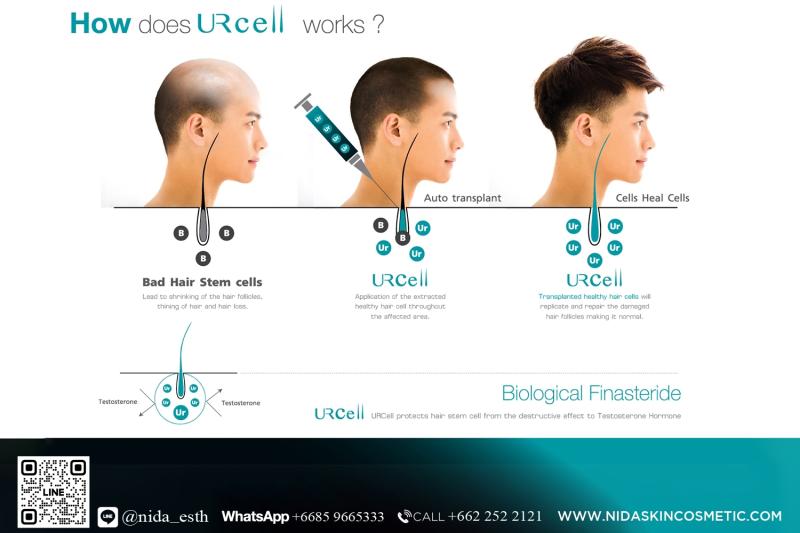
From 8-9 years of experience with over a thousand patients, We have concluded that Ur Cell Hair Micro Transplant shows promising results in
- Patients who develop alopecia as a result of hormonal and genetic issues or AGA in mild and moderate stages who still have living hair follicles in areas where they wish to receive the treatment.
- Proven to be successful with both men and women
- Proven to be successful for every ethnicity
- In cases where patients have already undergone hair transplant, this has been proven to increase hair thickness.
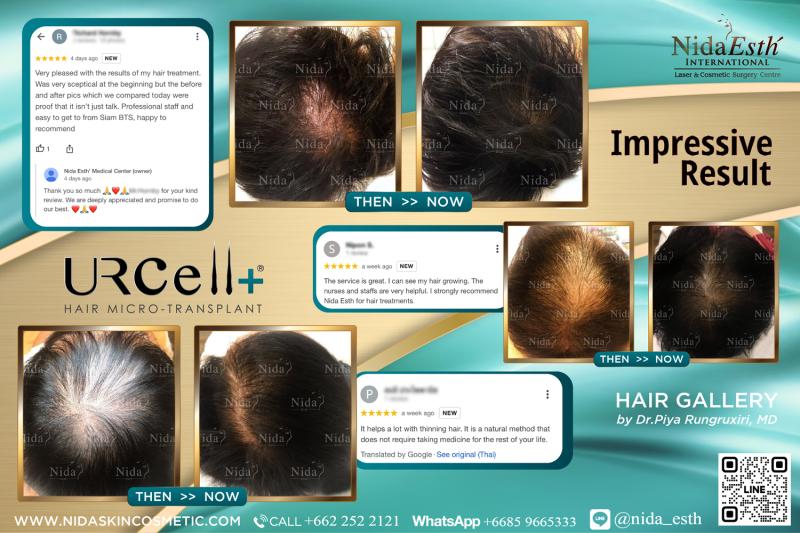
With our patient’s wishes and safety in mind, our medical team has decided on dividing the treatment into 3 phases in a timeframe of 3-6 months which can depend on the doctor’s decision with these factors in mind:
Pre-Micro Transplant
- Scan and analyze hair follicle cells with Nano Score Robotic System.
- Check out the Oxidative Stress Test to find free radicals in the blood that cause hair follicle cells to atrophy.
- Private consultation with the treating surgeon
- Design an Individual Micro Transplant with AI Plan.
Micro Transplant
- “Hair follicle cell transplant” by Pol. Lt. Col. Dr. Piya Rungruxsiri.
- Low - Level Laser Therapy. : The use of a low - level laser accelerates the cell division reaction.
Post – Micro Transplant
- Hair follicle cell nursery to ensure that previously implanted cells grow efficiently
- Hair Regenerative Therapy (HARG)
- Hair Hormone: Give hair hormone balance to adjust the balance of cells.
- Hair Nutrition
- Low - Level Laser Therapy: The use of a low - level laser accelerates the cell division reaction.
- Scan and analyze hair follicle cells with the Nano Score Robotic System to compare treatment results.
- Japanese herbs as home use regime in order to reduce the male hormonal effect around hair follicles and to promote division of healthy stem cells which are embedded into the hair follicles.
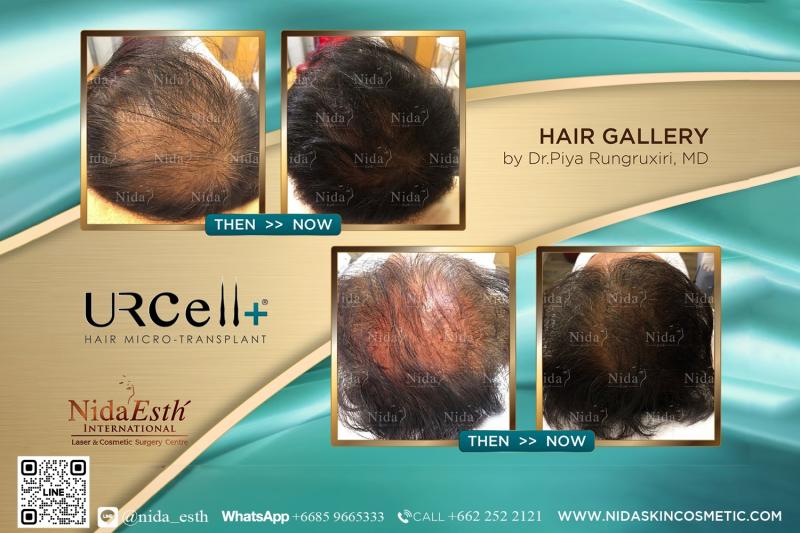
Good candidate
- Hair loss due to genetics and hormonal issues in mild to moderate degree.
- Patients who have already undergone hair transplant surgery but did not achieve the results they hoped to and are looking to find other procedure to enhance more results ,increase both hair density and thickness.
Advantages
- No oral medicine and surgery, no effects on reproductive system, no sexual dysfunction
- Improves both hair density and thickness
- No need to shave
Disadvantages
- The visible result of this treatment will not appear instantly. Regarding to natural hair cycle ,the signs of improvement will appear after 3- 4 months and will be fully successful after 6 months.
- Excellent result in Increasing both hair density and thickness around the center of the scalp but is unable to create new hair line where the hair follicles have already deteriorated.
HaiRestart is a revolutionary laser technology that Dr.Nida -CEO and founder of Nida Esth’ who is a highly-experienced Thai dermatologist & laser expert, first introduced this technology to her patients in 2021 when Fotona SP Dynamis Pro was first imported to Thailand for Nida Esth’.”Dr.Piya said.
Fotona SP Dynamis Pro at Nida Esth’ is the most advanced platform among the Fotona laser family which provides various programs for all cosmetic concerns from head to toe including non-surgical hair restoration program under the “laser concept”.
In Dr.Nida’s opinion : Hair Restart is one of her highly-recommended options for patients who don’t want to take any medicine or have any surgical procedures. “ I always recommend HaiRestart to my patients who’re struggling with hair loss problems.” Dr.Nida said. “ The procedure is gentle and comfortable. There is no pain- no Downtime-no bleeding-no injection-no oral medicine and no wounds to take care of. Patients can get back to work or their daily activities immediately after treatment. This is the reason why HaiRestart has become one of Nida Esth’ most popular services since then.”
“With Fotona Smooth, the optimal infrared Er:YAG laser 2940nm will be safely absorbed into the scalp to effectively stimulate dormant hair follicles and promote hair growth.”
“The results are fantastic! Patients who follow my treatment protocols strictly & regularly will definitely get perfect natural results.”
“A series of regular treatment every 10-14days is recommended for the best outcome . Number of treatment sessions may vary depending on causes & severity of hair loss. Normally around 6-12 sessions are needed.”
“From my 9-years of experience in the non-surgical hair restoration field, I personally found that HaiRestart can increase both the number & thickness of hair - but more dominant in thickness. So it becomes one of the best options for patients who underwent surgical hair transplant ( FUE, FUT) in the past but still have thin hair and want to increase hair thickness.”
“After a few treatment sessions, most patients experienced dramatic reduction of daily hair fall. This makes patients feel great and follow the protocol strictly.”
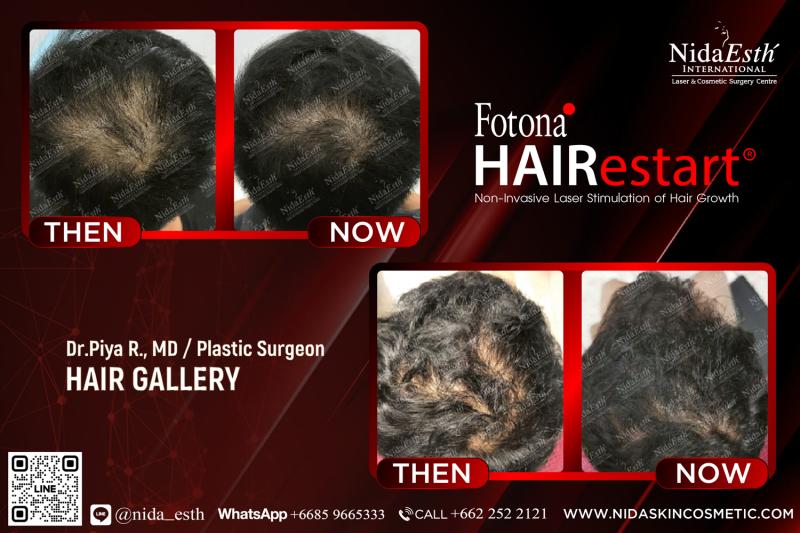
Good candidate
- AGA in any clinical stage
- No need to take medicine, no surgical procedures, no pain, no wounds to take care of
- Those who have underwent surgical hair transplant in the past but still have thin hair and want to increase hair thickness.
- People who have hair fall problems as well as thin hair and need natural results.
Advantages
- No oral medication
- No Surgery
- No pain
- No wound
- No downtime
- Prevent further hair loss
- Increase both hair density & thickness
- Promotion of new hair growth
- Safe & Effective ( confirmed by clinical research)
Disadvantages
- Several treatments are required. Every 10-14 days at least 6 sessions are recommended to see the best results.
1.3 Growth Factor Concept: Hair Vaccine by HARG (Hair Regenerative Therapy
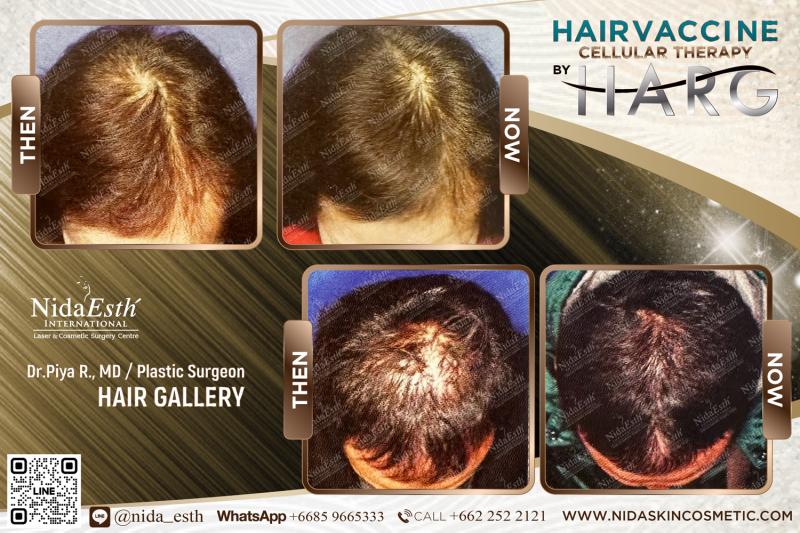
HARG therapy is a Japanese patented non-surgical hair restoration technique developed by Professor Dr. Hirotaro Fukuoka,MD- a famous Plastic surgeon and a lecturer in leading medical schools in Tokyo . HARG represents a sophisticated approach to hair restoration, focusing on the delivery of essential Adipose - derived Stem Cell growth factors directly to the hair follicles. Growth factors are proteins that play a critical role in cell signaling, influencing cell growth, proliferation, and differentiation.
The specific formulation of growth factors used in HARG therapy can be tailored to the patient’s unique needs, addressing their particular pattern of hair loss. Also, the microinjection technique used in HARG therapy is minimally invasive and generally well-tolerated, with little to no discomfort for the patient.
Patients can expect to see visible improvements in hair density and thickness within a few months of treatment. Regular sessions are recommended to maintain and enhance these results. Moreover, HARG therapy can be effectively combined with other hair restoration techniques, such as UR Cell Hair Micro Transplant+ or Fotona HAIRestart, to maximize outcomes.
2. Here are Good Candidates for Non-surgical Hair Transplants
Non-surgical hair transplants offer an effective solution for a broad spectrum of individuals experiencing hair loss. However, understanding who stands to benefit most from these treatments is crucial for achieving optimal results. Below, we detail the characteristics of ideal candidates for these advanced hair restoration procedures.
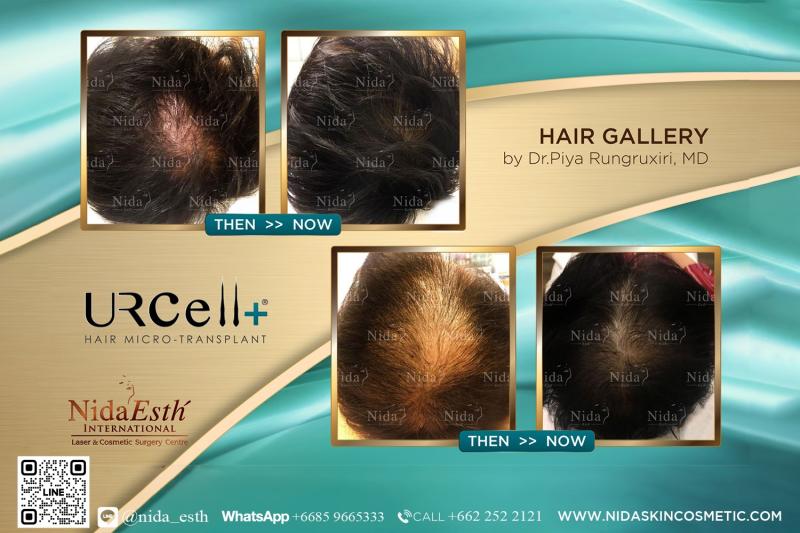
Early to Moderate Hair Loss
Non-surgical hair transplants are particularly effective for individuals who are in the early to moderate stages of hair loss. These patients often exhibit:
- Thinning Hair: Candidates who have noticed gradual thinning, rather than complete baldness, are ideal. This includes those who experience a widening part line, decreased hair volume, or more visible scalp.
- Receding Hairlines: Those with a receding hairline, particularly around the temples and forehead, can see substantial improvement with non-surgical treatments that stimulate new hair growth in these specific areas.
- Slower Hair Growth: Candidates whose hair grows slower than usual due to weakened follicles can benefit from treatments like Fotona HAIRestart, which revitalizes the follicles and promotes faster and thicker hair regrowth.
Patients Unwilling or Unable to Undergo Surgery
Non-surgical hair transplants are an excellent choice for individuals who prefer to avoid surgery due to various reasons:
- Fear of Surgery: Many individuals are apprehensive about the risks and discomfort associated with surgical procedures. Non-surgical options, such as those using stem cells or growth factors, provide a pain-free alternative with no need for incisions or anesthesia.
- Medical Conditions: Some patients have underlying health conditions that make them poor candidates for surgery. These can include cardiovascular diseases, uncontrolled diabetes, or blood clotting disorders.
- Busy Lifestyles: Individuals who cannot afford the downtime associated with surgical procedures, due to work or personal commitments, find non-surgical hair transplants appealing. The minimal recovery time and lack of visible post-procedure signs allow them to return to their normal activities almost immediately
Patients Seeking Natural-Looking Results
For those who prioritize natural-looking results, non-surgical hair transplants are ideal because these treatments stimulate and enhance the patient’s existing hair rather than introducing new grafts, leading to more natural regrowth that blends seamlessly with the patient's hair.
The results appear gradually over time, avoiding the sudden change in appearance that can occur with surgical transplants. This makes the transformation less noticeable to others, providing a subtle improvement that aligns with the patient’s natural hair growth cycle.
3. How Do They Work?
Each non-surgical hair transplant technique operates through a different mechanism as follows
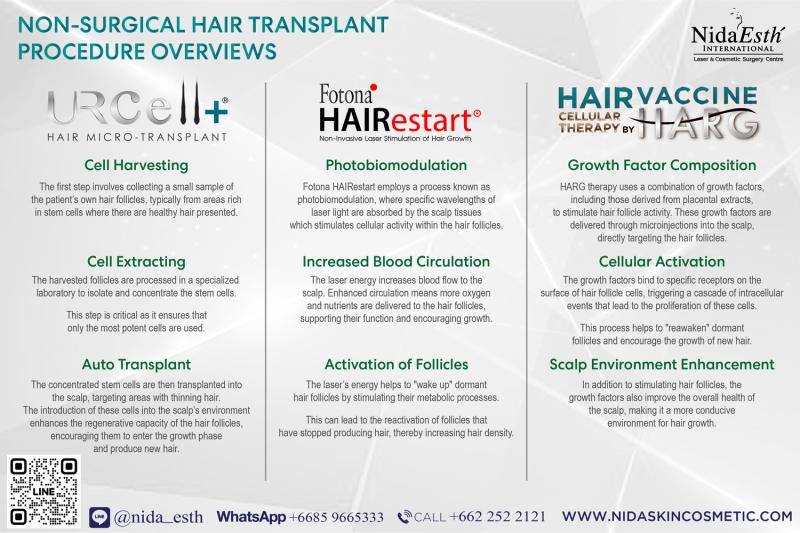
4. Let’s See Benefits of Non-surgical Hair Transplant
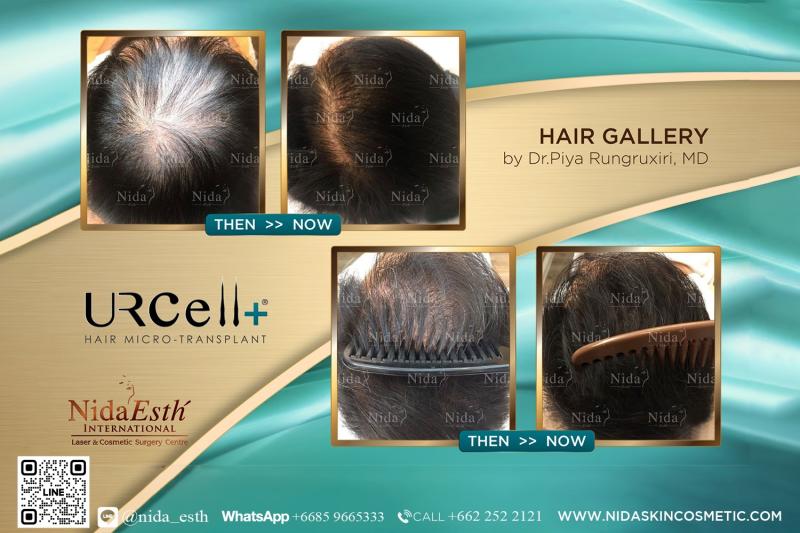
Non-surgical hair transplants have gained popularity due to their ability to offer effective hair restoration without the need for invasive procedures. Below are various benefits that make these treatments a compelling choice for many individuals experiencing hair loss.
1.Minimally Invasive: One of the primary benefits of non-surgical hair transplants is that they are minimally invasive, meaning:
- No Incisions or Sutures: Unlike traditional hair transplants, which require surgical incisions to transplant hair follicles, non-surgical methods such as UR Cell Hair Micro Transplant+ utilize advanced stem cell technology to stimulate existing follicles with only the need for a very tiny cuts and stitches.
- Reduced Pain and Discomfort: Patients experience minimal to no pain during the procedure, which is typically performed using topical anesthesia.
- No Scarring: Since there are no incisions, patients do not have to worry about linear scars on the scalp, making these treatments especially suitable for individuals who prefer short hairstyles.
- Quick Recovery: The lack of surgical intervention means patients can return to their daily activities almost immediately after treatment, with no need for extended downtime or recovery periods.
2.Natural and Gradual Results: The results from these treatments develop gradually, mimicking the natural hair growth cycle, which leads to a more authentic appearance.
3.Reduced Risk of Infection: The absence of surgical incisions significantly reduces the risk of infection, making these treatments safer for patients who may have concerns about healing or who are prone to complications from surgical procedures.
4.No Need for General Anesthesia: Non-surgical procedures are typically performed using local anesthesia or sedation, eliminating the risks associated with general anesthesia, such as allergic reactions or respiratory issues.
5.Beware of Limitations for Non-surgical Hair Transplant
While non-surgical hair transplants offer a variety of benefits, it’s crucial to understand the limitations to set realistic expectations and determine whether these treatments are the right choice for your specific condition.
- Not Suitable for Advanced Hair Loss: Non-surgical hair transplants are not ideal for those with advanced stages of hair loss, where significant baldness is present, or where hair follicles have become completely inactive as these treatments rely on the presence of active or at least partially active hair follicles. In cases of advanced baldness, where follicles are dormant, non-surgical methods may not be effective.
- More Time Required for Visible Results: Results from these treatments typically become noticeable after several months, as they rely on the body’s natural hair growth cycles. Patients seeking immediate results might find this timeline challenging.
- Multiple Sessions Required: One of the primary limitations of non-surgical hair transplants is the need for multiple treatment sessions to achieve optimal results. Unlike surgical hair transplants, which can yield significant changes in just one procedure, non-surgical methods work gradually, stimulating hair growth over time. Patients must commit to a series of sessions, often spaced several weeks apart, to see visible improvements.
- Maintenance May Be Necessary: Even after achieving the desired results, maintenance sessions are often required to sustain the effects of non-surgical hair transplants.
Non-surgical hair transplants represent a significant advancement in hair restoration technology, offering effective solutions for those looking to combat hair loss without the need for surgery. By focusing on stem cells, laser therapy, and growth factors, these treatments provide a natural, minimally invasive way to achieve fuller, healthier hair.
As a plastic surgeon, I have seen how these techniques can transform lives, restoring not just hair, but also confidence and self-esteem. If you are considering hair restoration, these non-surgical options are well worth exploring, providing a sophisticated alternative to traditional methods.
Author:
- Dr. Piya Rungruxsiri, MD, or Dr. Piya at Nida Esth' International
- Best Plastic Surgeons in Thailand
- A Board-certified Plastic Surgeon from General Surgery from Thai Medical Council & the International Society of Aesthetic Plastic Surgery (ISAP)
Membership:
- Member of Thai Society of Plastic and Reconstructive Surgeons of Thailand
- Member of Thai Society of Aesthetic Plastic Surgeons of Thailand
Education:
- Doctor of Medicine, Chulalongkorn University
- Board of General Surgery, Chulalongkorn University Hospital
- Board of Plastic & Reconstructive Surgery, Chulalongkorn University Hospital
Affiliated Hospitals


